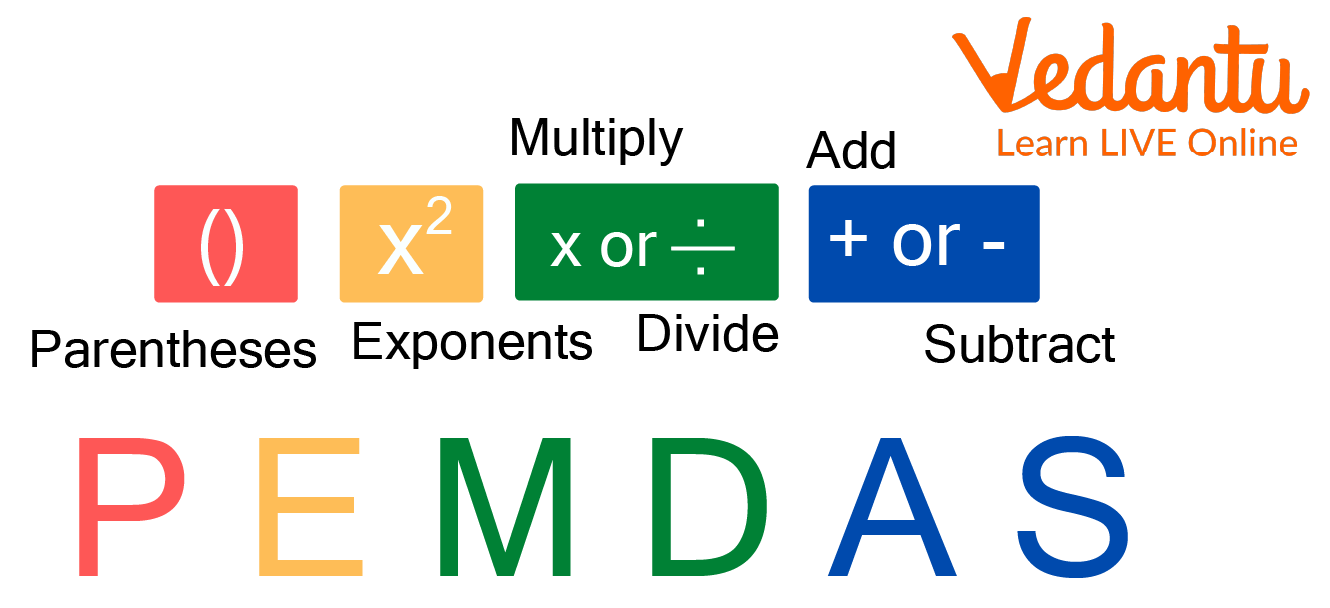




Step-by-Step Guide: Applying the PEMDAS Rule in Math Problems
It is always easier to deal with a single operation like only addition, subtraction, multiplication, or division. When a couple of them or all of the operations are involved at once, it becomes difficult to judge which operation must be fulfilled first.
In such a situation the PEMDAS rule comes into the picture.
Before diving into what is PEMDAS, the PEMDAS full form, situations where this is used and all other million questions in your mind, it’s important to un-wrap this concept part by part. Only then you will be able to answer the PEMDAS examples. Let’s jump right in!

What is PEMDAS?
What does PEMDAS Stand for?
PEMDAS is nothing but an abbreviation for the parts and order of different operations that have to be dealt with when multiple operations are involved in the given equation. PEMDAS full form helps us to remember the sequence of the operations that have to be performed.
If that is super complex to understand, it is the short form for the following parts:
P for Parentheses (or Brackets)
E for Exponents (squares and roots are called so)
M for Multiplication
D for Division
A for Addition
S for Subtraction
Why PEMDAS?
As remembering a whole list of operations is a lot more of a task than remembering this weird-sounding word! More than that, mathematics is a subject of organization and logic, so the PEMDAS rule proves just that.
This rule helps us understand the priorities of operations.
When given a list of things to do, we tend to panic and lose track of what to do first and what comes next. The PEMDAS method prevents this confusion and helps you get through the list of operations with ease.

Order of Operations According to The PEMDAS Rule
How is The PEMDAS Method Carried Out?
The full form of PEMDAS says pretty much everything about this method. Anyways, let’s brush through the steps one by one.
Step 1- Deal with the parentheses! Any operation within the brackets or parentheses must be solved first. Irrespective of it being addition, subtraction, multiplication, or division.
Step 2- Little numbers are the next big problem. Exponents! Square and Cube the given powers wherever necessary to jump to the next step.
Step 3- Always remember to start from the left and solve whatever comes first, be it multiplication or division.
Step 4- Same rule of left to the right applies here too! Solve whatever comes first, be it addition or subtraction.
Solved Examples
PEMDAS Examples with Answers
Q1. Solve the following equation using the PEMDAS method
$3 \times 6(7-4)-2^{2}+5 \times 6$
Ans: Solving what's given in the parentheses we get $3 \times 6(3)-2^{2}+5 \times 6$
Solving exponents given in the equation
$3 \times 6 \times 3-4+5 \times 6$
First we solve the multiplication and division from left to right $54-4+30$
Next, we solve the addition and subtraction from left to right
$54 - 4 + 30 = 80$
Final answer is 80
Q2. Solve the following equation using the PEMDAS method
$6^{2} \times(32-29)$
Ans: Solving what's given in the parentheses, we get $=6^{2} \times 3$
Solving exponents given in the equation $=36 \times 3$
Next, we solve the multiplication
$=108$
Final answer is 108
Q3. Solve the following equation using the PEMDAS method
$11^{2}-3(41+0-39)$
Ans: Solving what's given in the parentheses, we get
$=11^{2}-3 \times 2$
Solving the exponents in the equation
= 121 - 6
Now, subtracting 121 - 6 =115
Final answer is 115.
Q4. Solve the following equation using the PEMDAS method
= 24 × 4(65-23)
Ans: Solving what’s given in the parentheses
= 24 × 4 × 42
Now, multiplying we get 4032
Final answer is 4032.
Practice Problems
Q1. Solve the following equation using the PEMDAS method 4+3[8-2(6-3)]÷2
Ans: 39
Q2. Solve the following equation using the PEMDAS method 18÷(8-2×3)
Ans: 9
Q3. Solve the following equation using the PEMDAS method 20+34(45÷5)
Ans: 326
Q4. Solve the following equation using the PEMDAS method 10×5(20÷4)
Ans: 250
Q5. Solve the following equation using the PEMDAS method 8×5(88÷88)
Ans: 40
Summary
The PEMDAS rule gives the order of operations that has to be followed when dealing with a bunch of different operations. It stands for the following operations in the given order, P for parentheses, E for exponents, M for multiplication, D for division, A for addition, and S for Subtraction.
It is also necessary to remember another important rule of following from left to right i.e. operations on the left of the equation have to be followed before getting to the right of the equation. PEMDAS makes operations easier to perform. By practicing a few PEMDAS examples with answers, it becomes much easier.
FAQs on What Is the PEMDAS Rule?
1. What is the PEMDAS rule in Maths?
The PEMDAS rule is a mnemonic acronym used in mathematics to remember the correct order of operations required to solve an expression. It ensures that anyone solving a complex equation will arrive at the same, single correct answer. The rule specifies the sequence in which operations like addition, subtraction, multiplication, division, exponents, and parentheses should be performed.
2. What does each letter in the PEMDAS acronym stand for?
Each letter in PEMDAS represents a specific mathematical operation, dictating the order of priority:
P - Parentheses: First, solve all operations inside parentheses or brackets.
E - Exponents: Next, solve any terms with exponents (also known as powers or orders).
M - Multiplication: Then, perform multiplication.
D - Division: Perform division.
A - Addition: Then, perform addition.
S - Subtraction: Finally, perform subtraction.
3. In PEMDAS, does Multiplication always have to be done before Division?
No, this is a common misconception. Multiplication and Division have equal priority. You should perform these operations as they appear from left to right in the equation. For example, in the expression 16 ÷ 4 × 2, you would first perform the division (16 ÷ 4 = 4) and then the multiplication (4 × 2 = 8). The same principle applies to Addition and Subtraction, which also have equal priority and are solved from left to right.
4. How do you solve a problem using the PEMDAS rule step-by-step?
To solve a problem using PEMDAS, you follow the sequence of the acronym. Let's take the example: 5 + (4 × 3²) ÷ 2.
Step 1 (Parentheses): Solve the operation inside the parentheses first. Within (4 × 3²), we need to follow PEMDAS again.
Step 2 (Exponents): Inside the parentheses, solve the exponent: 3² = 9. The expression becomes 5 + (4 × 9) ÷ 2.
Step 3 (Multiplication): Complete the operation in the parentheses: 4 × 9 = 36. The expression is now 5 + 36 ÷ 2.
Step 4 (Division): Perform the division: 36 ÷ 2 = 18. The expression simplifies to 5 + 18.
Step 5 (Addition): Perform the final addition: 5 + 18 = 23. The final answer is 23.
5. Are PEMDAS and BODMAS different? Which one is correct?
Both PEMDAS and BODMAS are correct as they represent the same mathematical convention for the order of operations. The difference is purely in the terminology and is often regional (PEMDAS is common in the US, while BODMAS is used in India and the UK). The underlying rules are identical:
Parentheses (P) in PEMDAS is the same as Brackets (B) in BODMAS.
Exponents (E) is the same as Orders (O).
The rule for Multiplication/Division and Addition/Subtraction (solved left-to-right) remains the same for both.
Ultimately, they are just different acronyms to remember the same fundamental rule.
6. Why is learning the PEMDAS rule so important in mathematics?
Learning the PEMDAS rule is crucial because it provides a universal standard for calculation. Without a consistent order of operations, a single mathematical expression could yield multiple different answers, leading to confusion and errors. This rule ensures that everyone, from students to scientists, can interpret and solve an equation in the same way. It is a foundational concept essential for correctly solving problems in arithmetic, algebra, and beyond.
7. Who invented the PEMDAS rule?
The PEMDAS rule wasn't invented by a single person. Instead, it evolved over centuries as a standard convention among mathematicians to ensure there was no ambiguity when writing and interpreting mathematical expressions. While the exact history of the acronym is unclear, the rules it represents were gradually established and accepted by the mathematical community to create a consistent, universal language for calculations.

















